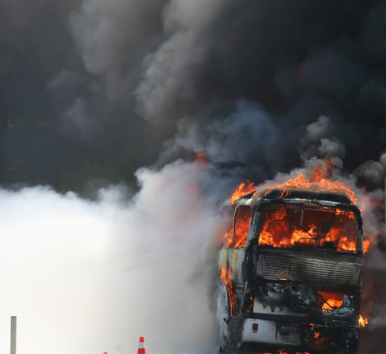
India has witnessed two devastating bus fire tragedies within weeks, raising serious concerns about road safety and passenger protection on long-distance journeys. These incidents, involving private sleeper buses, have claimed dozens of lives and exposed persistent safety lapses in the transportation sector.
Latest Incidents and Casualties
On October 24, 2025, a luxury sleeper bus traveling from Hyderabad to Bengaluru caught fire near Chinnatekuru village in Kurnool district, Andhra Pradesh. Around 43 passengers were onboard, and at least 20 people died after the bus collided with a motorcycle, rupturing its fuel tank and triggering a massive blaze. Investigations revealed the bus was also carrying 234 smartphones, whose lithium-ion batteries likely worsened the fire.
Earlier in October, another air-conditioned sleeper bus traveling from Jaisalmer to Jodhpur in Rajasthan caught fire near Thaiyat village. The overloaded bus was carrying 57 passengers, and the fire resulted in 20 deaths and 16 injuries.
In total, these back-to-back tragedies have claimed over 40 lives, leaving many families devastated and raising urgent questions about road safety standards.
Causes of the Tragedies
Several factors contributed to the severity of these incidents:
-
Collisions and Fuel Explosions – In both cases, accidents involving collisions triggered fires by rupturing fuel tanks.
-
Lithium-Ion Batteries – Hundreds of smartphones and bus batteries caught fire, creating rapid, uncontrollable flames. Lithium-ion batteries are prone to thermal runaway, which spreads fire quickly.
-
Overcrowding and Poor Maintenance – Buses were overloaded and lacked proper safety inspections, making evacuation difficult.
-
Flammable Interiors – Synthetic seats, curtains, and furnishings accelerated the spread of fire.
-
Lack of Emergency Preparedness – Many buses are not equipped with fire extinguishers, emergency exits, or clear evacuation instructions.
Steps Taken and Investigation
Authorities have launched investigations into negligent driving, regulatory violations, and illegal cargo transportation. The transport and fire departments have issued advisories to:
-
Ban the carrying of flammable cargo, including lithium-ion batteries, on passenger buses.
-
Ensure buses have fire suppression systems, smoke detectors, and emergency exits.
-
Conduct regular safety inspections and maintenance audits.
-
Train drivers and conductors on emergency evacuation procedures.
How Such Tragedies Can Be Prevented
Experts recommend several preventive measures:
-
Strict Regulation of Cargo – Passenger buses should not carry flammable goods.
-
Fire Safety Equipment – All buses must be equipped with extinguishers, heat sensors, and automatic suppression systems.
-
Use of Fire-Resistant Materials – Seats, curtains, and other furnishings should slow the spread of fire.
-
Passenger Awareness – Clear instructions on emergency exits and safety drills for passengers.
-
Technology Integration – AI-based monitoring for high temperatures or potential fire hazards on buses.
-
Enforcement of Traffic Safety Laws – Regular audits and strict penalties for overloading and negligent driving.
Conclusion
The recent bus fire tragedies in Andhra Pradesh and Rajasthan are a stark reminder of the risks facing passengers on India’s roads. While accidents may not always be avoidable, proper regulation, rigorous safety standards, and public awareness can significantly reduce casualties and prevent such disasters in the future.

